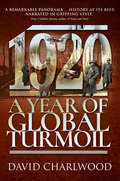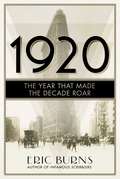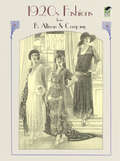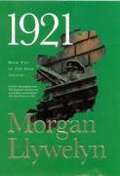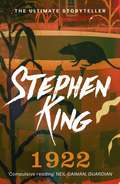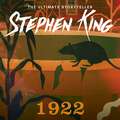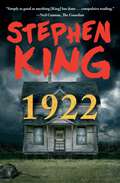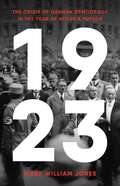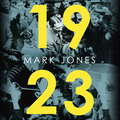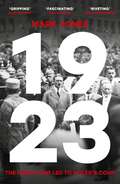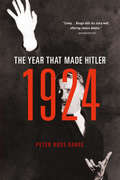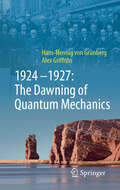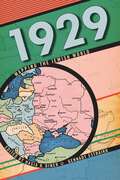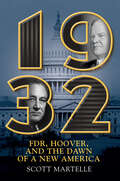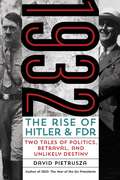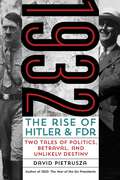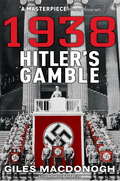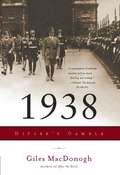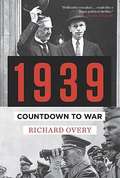- Table View
- List View
1920: A Year of Global Turmoil
by David Charlwood“History writing at its best . . . teasing out extraordinary parallels between our current world and that of a century ago.” —Tim Butcher, author of Blood RiverA pandemic has killed millions. Violent uprisings are tearing apart the Middle East. Nationalism is on the march in Europe. An unlikely candidate is running for president in the US on a populist platform to put “America first.” The year is 1920. 1920: A Year of Global Turmoil tells the story of twelve months that set in motion one hundred years of history. From America to Asia, the events of 1920 foreshadowed the decline of empires, the coming of another global conflict, and the rise of an American president who would change his country's relationship with the world. Weaving personal accounts with grand narrative, it vividly illuminates a past that echoes the present.
1920: The Year of the Six Presidents
by David PietruszaThe presidential election of 1920 was among history’s most dramatic. Six once-and-future presidents-Wilson, Harding, Coolidge, Hoover, and Teddy and Franklin Roosevelt-jockeyed for the White House. With voters choosing between Wilson’s League of Nations and Harding’s front-porch isolationism, the 1920 election shaped modern America. Women won the vote. Republicans outspent Democrats by 4 to 1, as voters witnessed the first extensive newsreel coverage, modern campaign advertising, and results broadcast on radio. America had become an urban nation: Automobiles, mass production, chain stores, and easy credit transformed the economy. 1920 paints a vivid portrait of America, beset by the Red Scare, jailed dissidents, Prohibition, smoke-filled rooms, bomb-throwing terrorists, and the Klan, gingerly crossing modernity’s threshold.
1920: The Year that Made the Decade Roar
by Eric BurnsOne of the most dynamic eras in American history--the 1920s--began with this watershed year that would set the tone for the century to follow. "The Roaring Twenties" is the only decade in American history with a widely applied nickname, and our collective fascination with this era continues. But how did this surge of innovation and cultural milestones emerge out of the ashes of The Great War? No one has yet written a book about the decade's beginning. Acclaimed author Eric Burns investigates the year of 1920, which was not only a crucial twelve-month period of its own, but one that foretold the future, foreshadowing the rest of the 20th century and the early years of the 21st, whether it was Sacco and Vanzetti or the stock market crash that brought this era to a close. Burns sets the record straight about this most misunderstood and iconic of periods. Despite being the first full year of armistice, 1920 was not, in fact, a peaceful time--it contained the greatest act of terrorism in American history to date. And while 1920 is thought of as starting a prosperous era, for most people, life had never been more unaffordable. Meanwhile, African Americans were putting their stamp on culture and though people today imagine the frivolous image of the flapper dancing the night away, the truth was that a new kind of power had been bestowed on women, and it had nothing to do with the dance floor. . . From prohibition to immigration, the birth of jazz, the rise of expatriate literature, and the original Ponzi scheme, 1920 was truly a year like no other.
1920s Fashions from B. Altman & Company
by Altman Co.Over 700 black-and-white illustrations, detailed descriptions, and prices for a vast array of upscale women's clothing and accessories appear among these highlights from rare 1920s B. Altman & Company catalogs. Stylized drawings of flappers depict sophisticated dresses, bathing suits, cloche hats, shoes, and more. A selection of attire for men and children is included.
1921 The Great Novel of the Irish Civil War
by Morgan LlywelynNovel about the beginning of Irish independence from England, and the subsequent civil war, seen through the eyes of a fictional journalist. Some violence.
1922
by Jean-Michel Rabaté1922: Literature, Culture, Politics examines key aspects of culture and history in 1922, a year made famous by the publication of several modernist masterpieces, such as T. S. Eliot's The Waste Land and James Joyce's Ulysses. Individual chapters written by leading scholars offer new contexts for the year's significant works of art, philosophy, politics, and literature. 1922 also analyzes both the political and intellectual forces that shaped the cultural interactions of that privileged moment. Although this volume takes post-World War I Europe as its chief focus, American artists and authors also receive thoughtful consideration. In its multiplicity of views, 1922 challenges misconceptions about the 'Lost Generation' of cultural pilgrims who flocked to Paris and Berlin in the 1920s, thus stressing the wider influence of that momentous year.
1922
by Stephen KingThe chilling novella featured in Stephen King's bestselling collection Full Dark, No Stars, 1922 - about a man who succumbs to the violence within - is now available as a stand-alone publication.I believe there is a man inside every man, a strangerSo writes Wilfred James in his confession. It's 1922. Wilfred owns eighty acres of farmland in Nebraska that have been in the family for generations. His wife, Arlette, owns an adjoining one hundred acres.But if Arlette carries out her threat to sell her land to a pig butcher, Wilfred will be forced to sell too. Worse, he'll have to move to the city. But he has a daring plan. It may work if he can persuade his son. A powerful tale of betrayal, murder, madness and rats, 1922 is a breathtaking exploration into the dark side of human nature from the great American storyteller Stephen King. It was adapted into a film from Netflix.
1922
by Stephen KingThe chilling novella featured in Stephen King's bestselling collection Full Dark, No Stars, 1922 - about a man who succumbs to the violence within - is now available as a stand-alone publication.I believe there is a man inside every man, a strangerSo writes Wilfred James in his confession. It's 1922. Wilfred owns eighty acres of farmland in Nebraska that have been in the family for generations. His wife, Arlette, owns an adjoining one hundred acres.But if Arlette carries out her threat to sell her land to a pig butcher, Wilfred will be forced to sell too. Worse, he'll have to move to the city. But he has a daring plan. It may work if he can persuade his son. A powerful tale of betrayal, murder, madness and rats, 1922 is a breathtaking exploration into the dark side of human nature from the great American storyteller Stephen King. It was adapted into a film from Netflix.(P) 2010 Simon & Schuster, Inc.
1922
by Stephen KingThe chilling novella featured in Stephen King&’s New York Times bestselling collection Full Dark, No Stars, 1922 is about a man who succumbs to the violence within—setting in motion a grisly train of murder and madness.Wilfred James owns eighty acres of farmland in Nebraska that have been in his family for generations. His wife, Arlette, owns an adjoining one hundred acres. She wants to sell her land but if she does, Wilfred will be forced to sell as well. James will do anything to hold onto his farm, and he'll get his son to go along. Betrayal, murder, madness, rats, 1922 is a breathtaking exploration into the dark side of human nature from the great American storyteller Stephen King.
1923: The Crisis of German Democracy in the Year of Hitler's Putsch
by Mark William JonesHow Germany&’s fledgling democracy nearly collapsed in 1923—and how pro-democracy forces fought back In 1923, the Weimar Republic faced a series of crises, including foreign occupation of its industrial heartland, rampant inflation, radical violence, and finally Hitler&’s infamous &“beer hall putsch.&” Fanning the flames of anti-government and anti-Semitic sentiment, the Nazis tried to violently seize power in Munich, only failing after they were abandoned by like-minded conservatives. In 1923, historian Mark William Jones draws on new research to offer a revealing portrait of German politics and society in this turbulent year. Tracing Hitler&’s early rise, Jones reveals how political pragmatism and unprecedented international cooperation with the West brought Germany out of its crisis year. Although Germany would succumb to tyranny a decade later, the story of the republic&’s survival in 1923 offers essential lessons to anyone concerned about the future of democracy today.
1923: The Forgotten Crisis in the Year of Hitler’s Coup
by Mark JonesThe astonishing year when German democracy faced crisis and near destruction.1923 was one of the most remarkable years of modern European history. In January, France and Belgium militarily occupied Germany's economic heartland, the Ruhr; triggering a series of crises that almost spiralled out of control. Hyperinflation plunged millions into poverty. The search for scapegoats empowered political extremes. Hitler's populism ascended to national prominence. Communists, Nazis, separatists all thought that they could use the crises to destroy democracy. None succeeded. 1923 was the year of Hitler's first victory - and his first defeat. Fanning the flames of instability, anti-government and antisemitic sentiment, the Nazis abortive yet pivotal putsch in a Munich beer hall failed when they were abandoned by their likeminded conservative allies. Drawing on previously unseen sources, Mark Jones weaves together a thrilling and resonant narrative of German lives in this turbulent time. Tracing Hitler's rise, we see how political pragmatism and international cooperation eventually steered the nation away from total insurrection. A decade later, when Weimar democracy eventually succumbed to tyranny, the warnings from 1923 - rising of nationalist rhetoric, fragile European consensus, and underestimation the of the enemies of liberalism - became only too apparent.This account of the republic's convulsions and survival offer a gripping image of a modern society in extreme crisis.
1923: The Forgotten Crisis in the Year of Hitler’s Coup
by Mark Jones'Gripping . . . thoroughly researched and beautifully written . . . a warning for our times' Alex Watson, author of Ring of Steel'Fascinating . . . shows powerfully that there was nothing inevitable about the survival of Germany's young democracy in that year - nor about its death a decade later. A timely reminder' Katja Hoyer, author of Beyond the WallThe astonishing year when German democracy faced crisis and near destruction.1923 was one of the most remarkable years of modern European history. In January, France and Belgium militarily occupied Germany's economic heartland, the Ruhr; triggering a series of crises that almost spiralled out of control. Hyperinflation plunged millions into poverty. The search for scapegoats empowered political extremes. Hitler's populism ascended to national prominence. Communists, Nazis, separatists all thought that they could use the crises to destroy democracy. None succeeded. 1923 was the year of Hitler's first victory - and his first defeat. Fanning the flames of instability, anti-government and antisemitic sentiment, the Nazis' abortive yet pivotal putsch in a Munich beer hall failed when they were abandoned by their likeminded conservative allies. Drawing on previously unseen sources, Mark Jones weaves together a thrilling and resonant narrative of German lives in this turbulent time. Tracing Hitler's rise, we see how political pragmatism and international cooperation eventually steered the nation away from total insurrection. A decade later, when Weimar democracy eventually succumbed to tyranny, the warnings from 1923 - rising of nationalist rhetoric, fragile European consensus, and underestimation the of the enemies of liberalism - became only too apparent.This account of the republic's convulsions and survival offers a gripping image of a modern society in extreme crisis.
1924: The Year That Made Hitler
by Peter Ross RangeThe dark story of Adolf Hitler's life in 1924--the year that made a monsterBefore Adolf Hitler's rise to power in Germany, there was 1924. This was the year of Hitler's final transformation into the self-proclaimed savior and infallible leader who would interpret and distort Germany's historical traditions to support his vision for the Third Reich. Everything that would come--the rallies and riots, the single-minded deployment of a catastrophically evil idea--all of it crystallized in one defining year. 1924 was the year that Hitler spent locked away from society, in prison and surrounded by co-conspirators of the failed Beer Hall Putsch. It was a year of deep reading and intensive writing, a year of courtroom speeches and a treason trial, a year of slowly walking gravel paths and spouting ideology while working feverishly on the book that became his manifesto: Mein Kampf.Until now, no one has fully examined this single and pivotal period of Hitler's life. In 1924, Peter Ross Range richly depicts the stories and scenes of a year vital to understanding the man and the brutality he wrought in a war that changed the world forever.
1924–1927: The Dawning of Quantum Mechanics
by Hans-Hennig von Grünberg Alex GriffithsIn June of 1925, almost a hundred years ago, Werner Heisenberg spent ten days on the island of Heligoland - thanks to his hayfever. This respite afforded him the time to write an article that would mark the beginning of the history of modern quantum theory. Two years later, in October of 1927, the fifth Solvay Conference, arguably the most famous gathering in the history of physics, took place in Brussels, bringing the riveting story of the origins of quantum mechanics to a close. During this crucial and relatively short period between 1925 and 1927, eight physicists from five countries developed a theory that would radically change the physical understanding of our world and would become the basis for almost all advanced technologies: transistors, lasers, light-emitting diodes, medical imaging, the electron microscope and much more. The reader will travel through time from September 1924 to October 1927 and learn by way of monthly entries how quantum mechanics came into being, what the people involved experienced and thought in the context of the time they lived in, and how a unified whole slowly emerged from the interactions of these individuals. The book is aimed at laypeople who are fascinated by quantum mechanics and its history. They will learn that this theory, like Anita Berber, jazz or the invention of television, is a characteristic child of the 1920s.
1928 Diagnostics: Fighting Antibiotics Resistance
by Daniela Beyersdorfer Ariel D. SternIn 2019, the co-founders of the Swedish medical start-up 1928 Diagnostics, CEO Dr. Kristina Lagerstedt and COO Dr. Susanne Staaf, had to pick the right business model to commercialize their novel technology to hospitals and health care providers. Developed in partnership with research hospitals to help fight the global antibiotic resistance crisis, the firm's cloud-based technology platform helped partners identify resistant genes and mutations in bacteria more quickly and accurately, allowing for easier outbreak cluster tracking in support of hospital infection control management, as well as better diagnostics and antibiotic selection. By 2019, they had raised $5 million, employed 16 people, and had their tool deployed at 24 partner sites in 10 different countries. Their decisions on which markets to focus on and with which business model would crucially impact the young firm's chances at successfully converting existing users and attracting new clients.
1929: Mapping the Jewish World (Alternative Criminology #13)
by Gennady Estraikh Hasia R DinerWinner of the 2013 National Jewish Book Award, Anthologies and CollectionsThe year 1929 represents a major turning point in interwar Jewish society, proving to be a year when Jews, regardless of where they lived, saw themselves affected by developments that took place around the world, as the crises endured by other Jews became part of the transnational Jewish consciousness. In the United States, the stock market crash brought lasting economic, social, and ideological changes to the Jewish community and limited its ability to support humanitarian and nationalist projects in other countries. In Palestine, the anti-Jewish riots in Hebron and other towns underscored the vulnerability of the Zionist enterprise and ignited heated discussions among various Jewish political groups about the wisdom of establishing a Jewish state on its historical site. At the same time, in the Soviet Union, the consolidation of power in the hands of Stalin created a much more dogmatic climate in the international Communist movement, including its Jewish branches. Featuring a sparkling array of scholars of Jewish history, 1929 surveys the Jewish world in one year offering clear examples of the transnational connections which linked Jews to each other—from politics, diplomacy, and philanthropy to literature, culture, and the fate of Yiddish—regardless of where they lived. Taken together, the essays in 1929 argue that, whether American, Soviet, German, Polish, or Palestinian, Jews throughout the world lived in a global context.
1930: The Story of a Baseball Season When Hitters Reigned Supreme
by Lew FreedmanThe 1930 Major League baseball season was both marvelous and horrendous, great for hitters, embarrassing for pitchers. In totality it was just this side of insane as an outlier among all seasons.Major League Baseball began with the founding of the National League in 1876. In the 145 seasons since then, one season stands out as unique for the astounding nature of hitting: 1930.A flipside of 1968&’s &“Year of the Pitcher,&” when the great St. Louis Cardinals Bob Gibson compiled a 1.12 earned run average and Detroit Tigers Denny McLain won 31 games, the 1930 season was when the batters reigned supreme. During this incredible season, more than one hundred players batted .300, the entire National League averaged .300, ten players hit 30 or more home runs, and some of the greatest individual performances established all-time records. From New York Giants Bill Terry&’s .401 average—the last National Leaguer to hit over .400—to the NL-record 56 home runs and major league–record 192 runs batted in by Chicago Cubs Hack Wilson, the 1930 season is a wild, sometimes unbelievable, often wacky baseball story.Breaking down the anomaly of the season and how each team fared, veteran journalist Lew Freeman tells the story of a one-off year unlike any other. While the greats stayed great, and though some pitchers did hold their own—with seven winning 20 or more games, including 28 by Philadelphia Athletics&’ Lefty Grove and 25 by Cleveland Indians&’ Wes Ferrell—Freedman shares anecdotes about those players that excelled in 1930, and only 1930. More than ninety years later, 1930 offers insight into a season that still stands the test of time for batting excellence.
1932: FDR, Hoover, and the Dawn of a New America
by Scott MartelleA fascinating behind-the-scenes look at a year in American history that still resonates today, 1932: FDR, Hoover, and the Dawn of a New America tells the story of a battered nation fighting for its own future amid the depths of the Great Depression. At the start of 1932, the nation&’s worst economic crisis has left one-in-four workers without a job, countless families facing eviction, banks shutting down as desperate depositors withdraw their savings, and growing social and political unrest from urban centers to the traditionally conservative rural heart of the country. Amid this turmoil, a political decision looms that will determine the course of the nation. It is a choice between two men with very diferent visions of America: Incumbent Republican Herbert Hoover with his dogmatic embrace of small government and a largely unfettered free market, and New York&’s Democratic Governor Franklin Delano Roosevelt and his belief that the path out of the economic crisis requires government intervention in the economy and a national sense of shared purpose. Now veteran journalist Scott Martelle provides a gripping narrative retelling of that vitally significant year as social and political systems struggled under the weight of the devastating Dust Bowl, economic woes, rising political protests, and growing demand for the repeal of Prohibition. That November, voters overwhelmingly rejected decades of Republican rule and backed Roosevelt and his promise to redefine the role of the federal government while putting the needs of the people ahead of the wishes of the wealthy. Deftly told, this illuminating work spotlights parallel events from that pivotal year and brings to life figures who made headlines in their time but have been largly forgotten today. Ultimately, it is the story of a nation that, with the help of a leader determined to unite and inspire, took giant steps toward a new America.
1932: The Rise of Hitler and FDR--Two Tales of Politics, Betrayal, and Unlikely Destiny
by David PietruszaTwo Depression-battered nations confronted destiny in 1932, going to the polls in their own way to anoint new leaders, to rescue their people from starvation and hopelessness. America would elect a Congress and a president ebullient aristocrat Franklin Roosevelt or tarnished Wonder Boy Herbert Hoover. Decadent, divided Weimar Germany faced two rounds of bloody Reichstag elections and two presidential contests doddering reactionary Paul von Hindenburg against rising radical hate-monger Adolf Hitler. The outcome seemed foreordained unstoppable forces advancing upon crumbled, disoriented societies. A merciless Great Depression brought greater perhaps hopeful, perhaps deadly transformation: FDR s New Deal and Hitler s Third Reich. But neither outcome was inevitable. Readers enter the fray through David Pietrusza s page-turning account: Roosevelt s fellow Democrats may yet halt him at a deadlocked convention. 1928 s Democratic nominee, Al Smith, harbors a grudge against his one-time protege. Press baron William Randolph Hearst lays his own plans to block Roosevelt s ascent to the White House. FDR s politically-inspired juggling of a New York City scandal threatens his juggernaut. In Germany, the Nazis surge at the polls but twice fall short of Reichstag majorities. Hitler, tasting power after a lifetime of failure and obscurity, falls to Hindenburg for the presidency also twice within the year. Cabals and counter-cabals plot. Secrets of love and suicide haunt Hitler. Yet guile and ambition may yet still prevail. 1932 s breathtaking narrative covers two epic stories that possess haunting parallels to today s crisis-filled vortex. It is an all-too-human tale of scapegoats and panaceas, class warfare and racial politics, of a seemingly bottomless depression, of massive unemployment and hardship, of unprecedented public works/infrastructure programs, of business stimulus programs and damaging allegations of political cronyism, of waves of bank failures and of mortgages foreclosed, of Washington bonus marches and Berlin street fights, of once-solid financial empires collapsing seemingly overnight, of rapidly shifting social mores, and of mountains of irresponsible international debt threatening to crash not just mere nations but the entire global economy. It is the tale of spell-binding leaders versus bland businessmen and out-of-touch upper-class elites and of two nations inching to safety but lurching toward disaster. It is 1932 s nightmare with lessons for today. "
1932: The Rise of Hitler and FDR--Two Tales of Politics, Betrayal, and Unlikely Destiny
by David PietruszaTwo Depression-battered nations confronted destiny in 1932, going to the polls in their own way to anoint new leaders, to rescue their people from starvation and hopelessness. America would elect a Congress and a president—ebullient aristocrat Franklin Roosevelt or tarnished &“Wonder Boy&” Herbert Hoover. Decadent, divided Weimar Germany faced two rounds of bloody Reichstag elections and two presidential contests—doddering reactionary Paul von Hindenburg against rising radical hate-monger Adolf Hitler.The outcome seemed foreordained—unstoppable forces advancing upon crumbled, disoriented societies. A merciless Great Depression brought greater—perhaps hopeful, perhaps deadly—transformation: FDR&’s New Deal and Hitler&’s Third Reich.But neither outcome was inevitable.Readers enter the fray through David Pietrusza&’s page-turning account: Roosevelt&’s fellow Democrats may yet halt him at a deadlocked convention. 1928&’s Democratic nominee, Al Smith, harbors a grudge against his one-time protege. Press baron William Randolph Hearst lays his own plans to block Roosevelt&’s ascent to the White House. FDR&’s politically-inspired juggling of a New York City scandal threatens his juggernaut. In Germany, the Nazis surge at the polls but twice fall short of Reichstag majorities. Hitler, tasting power after a lifetime of failure and obscurity, falls to Hindenburg for the presidency—also twice within the year. Cabals and counter-cabals plot. Secrets of love and suicide haunt Hitler.Yet guile and ambition may yet still prevail.1932&’s breathtaking narrative covers two epic stories that possess haunting parallels to today&’s crisis-filled vortex. It is an all-too-human tale of scapegoats and panaceas, class warfare and racial politics, of a seemingly bottomless depression, of massive unemployment and hardship, of unprecedented public works/infrastructure programs, of business stimulus programs and damaging allegations of political cronyism, of waves of bank failures and of mortgages foreclosed, of Washington bonus marches and Berlin street fights, of once-solid financial empires collapsing seemingly overnight, of rapidly shifting social mores, and of mountains of irresponsible international debt threatening to crash not just mere nations but the entire global economy.It is the tale of spell-binding leaders versus bland businessmen and out-of-touch upper-class elites and of two nations inching to safety but lurching toward disaster. It is 1932&’s nightmare—with lessons for today.
1933
by Philip Metcalfe"Using letters, diaries, and memoirs, Metcalfe distills the personalities, viewpoints, and day-to-day reactions of five alert and often directly involved witnesses to Hitler's consolidation of power. They are: U.S. Ambassador to Germany, William Dodd, and his high-spirited daughter, Martha; Bella Fromm, a glamorous German society columnist who was Jewish and made no secret of it; Ernest Hanfstaengl, Hitler's somewhat buffoonish foreign-press chief; and Rudolf Diels, the first head of the Gestapo." --Publishers Weekly
1936 ... On the Continent
by Eugene FodorThis guide takes you on a prewar journey through 30 European countries, including the British Isle.
1938: Hitler's Gamble
by Giles MacDonoghIn this masterly new work, acclaimed historian Giles MacDonogh explores the moment when Hitler gambled everything. Until 1938, Hitler could be dismissed as a ruthless but efficient dictator, a problem to Germany alone; after 1938 he was clearly a threat to the entire world.In that year The Third Reich came of age and the Führer showed his hand - bringing Germany into line with Nazi ideology and revealing long-held plans to take back those parts of Europe lost to 'Greater Germany' after the First World War. The sequence of events began in January with the purging of the army, and escalated with the merger with Austria - the Anschluss, and the first persecutions of Viennese Jewry.In the following months Hitler moulded the nation to his will. Elections brought him a 99 per cent approval rating. MacDonogh gives a full account of the nationalist opposition that failed to topple Hitler in September 1938. By the end of the year the brutal reality of the Nazi regime was revealed by Joseph Goebbels in Kristallnacht, a nationwide assault on Germany's native Jewish population.MacDonogh's access to many new sources gives insights into what life was like under the eye of the regime, revealing the role of the Anglican Church after the Anschluss, saving those Jews who were willing to convert, and also the Kendrick Affair - the still-secret details of the Austrian double agent who brought down the whole MI6 operation in Austria and Germany, just as the Chamberlain government began negotiations with Hitler at Munich. A remarkable and revealing account of Hitler's opening moves to war.
1938: Hitler's Gamble
by Giles MacdonoghIn this masterful narrative, acclaimed historian Giles MacDonogh chronicles Adolf Hitler's consolidation of power over the course of one year. Until 1938, Hitler could be dismissed as a ruthless but efficient dictator, a problem to Germany alone; after 1938 he was clearly a threat to the entire world. It was in 1938 that Third Reich came of age. The Führer brought Germany into line with Nazi ideology and revealed his plans to take back those parts of Europe lost to "Greater Germany" after the First World War. From the purging of the army in January through the Anschluss in March, from the Munich Conference in September to the ravages of Kristallnacht in November, MacDonogh offers a gripping account of the year Adolf Hitler came into his own and set the world inexorably on track to a cataclysmic war.
1939
by Richard OveryThe world burst into war in a blast of bombs and tanks when the Nazis marched into Poland. Blitzkriegmoves from the aftermath of World War I into the dramatic events of 1938-41. Rare items of memorabilia-including Hitler’s order to invade Poland and Montgomery’s diary charting the evacuation from Dunkirk-bring the era and events to life as never before. The CD features Chamberlain’s announcement of war; Churchill’s "finest hour” speech; and Hitler’s first speech from the newly German Danzig.
